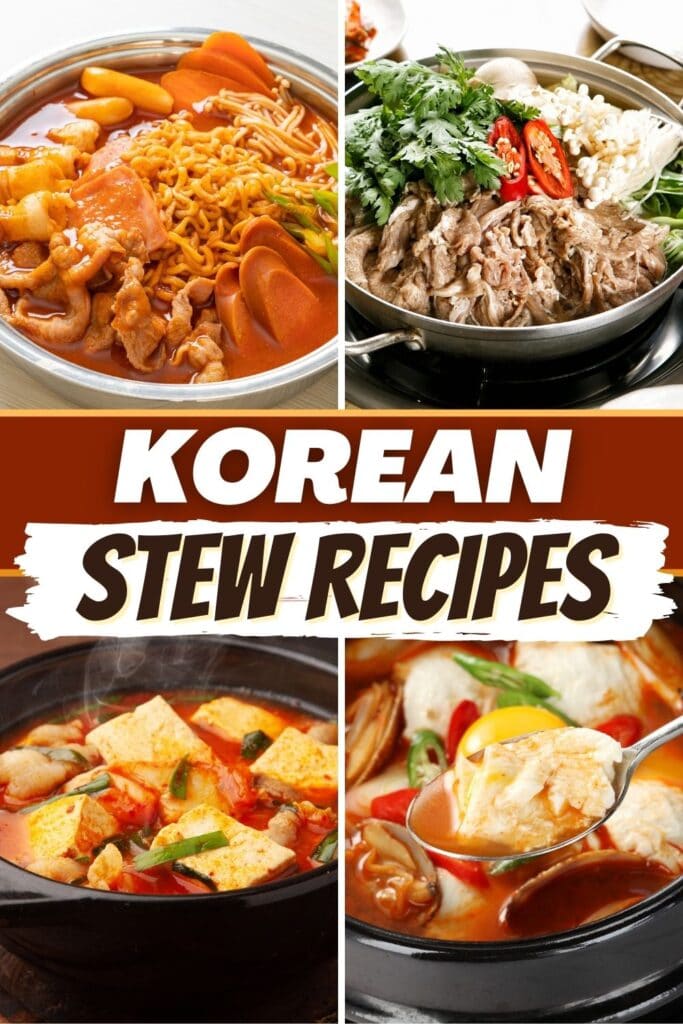In terms of Asian food, Korean stew recipes often take a backseat to Chinese, Japanese, and Indian food in places outside of Asia.
However, once you’ve tried a couple of these dishes, you’ll want to incorporate more Korean cuisine into your regular diet.

Many of these stews feature seafood, a common staple of the Korean diet.
However, if you’re not big on fish and other seafood, there are some options here without it.
If you’re looking for something spicy, start with domi maeuntang.
If you need a vegetarian or vegan option, check out the recipe for Korean gochujang soup instead.
Now, let’s get to these ten delicious Korean stew recipes.
1. Budae Jjigae (Army Stew)
Whether you call it budae jjigae or army stew, there’s no denying that this Korean stew is fantastic.
It’s also easy to make, and the recipe is highly adjustable.
In fact, as long as you have some type of processed meat (this recipe calls for spam and bacon) and kimchi, you can make budae jjigae.
All the other ingredients are somewhat optional and can be adjusted to suit your tastes.
There are tons of army stew recipes online, but this one is one of my favorites.
I enjoy its heartiness and the taste and texture of the mushroom caps, scallions, and onions.
I make mine with chicken stock instead of anchovy broth, but I imagine it’s good either way.
2. Bulgogi Jeongol (Korean Beef Hot Pot)
If you prefer your stews so thick and chunky that they don’t even look like stews, you’ll probably enjoy the Korean beef hot pot.
It’s less of a stew and more of a saucy dish of yummy things.
You’ll pile it high with sliced ribeye, konnyaku noodles, onions (white and green), tofu, mushrooms, and more.
Then, you’ll coat everything with a sweet and savory sauce and sesame seeds.
If you’re looking for something that’ll fill you up and keep you that way for hours, this recipe is perfect.
3. Domi Maeuntang (Spicy Fish Stew with Red Snapper)
Domi maeuntang is for anyone who enjoys spiciness and a wallop of umami flavor. To get the strongest seafood flavor, you’ll use anchovy broth as a base.
To that, you’ll add a whole snapper, some small clams, and fish (or soy) sauce.
Throw in a bunch of veggies and herbs (including ginger for heat), and you’ll have a wonderful meal.
The stew won’t exactly set your mouth on fire, but it’s pretty spicy, so proceed with caution if you’re not used to eating hot foods.
4. Kimchi Jjigae (Kimchi Stew)
You can make this simple, flavorful Korean stew with only ten ingredients, though you may need to visit your local Asian market to find some of them.
Finding the pork belly, garlic, oil, tofu, scallions, salt, and pepper shouldn’t be difficult.
However, fermented kimchi, gochugaru, and kimchi juice might be harder to find.
The good news is that tracking down the ingredients (which you can easily do online if all else fails) is the hardest part of making this tasty stew.
Once you have everything ready, you can make it one pot with just five easy-to-follow steps. It shouldn’t take longer than an hour tops.
5. Mackerel Pike Kimchi Stew
If you’ve ever smelled mackerel cooking, you might be tempted to scroll past this one without checking it out.
I know that mackerel is not the best smelling food in the world.
However, this recipe uses mackerel pike, which is an entirely different fish and not nearly as stinky.
Plus, the other ingredients in the stew – kimchi, onions, garlic, ginger, gochugaru, green onions, red and green chiles, and more – are robust, flavorful foods in their own right.
So if you like a rich, chunky stew with lots of flavor, give this one a chance.
6. Kimchi Soondubu Jjigae (Soft Tofu Stew)
This quick, 25-minute stew is an excellent option for those rushed evenings when cooking isn’t the first thing on your mind.
With plenty of meat and seafood, lots of spices and seasonings, and soft, nicely textured tofu, it’s one chunky stew that the whole family will appreciate.
Feel free to add a dash or two of ginger if you enjoy a bit of spiciness to your food.
7. Kongbiji Jjigae (Ground Soybean Stew)
I enjoy this lovely orange stew because it’s easy to make, especially if you opt for the Instant Pot method, and it’s surprisingly filling.
However, the odd texture turns some people off; it’s creamy and delicious, but some people find it a bit grainy.
If you notice that happening, try pureeing your soybeans a little longer.
You can also add more water. Just be cautious if you go that route, as adding too much can make the stew too thin.
8. Korean Gochujang Soup (Gochujang Stew)
I like anything that I can make in half an hour in one pot, so this Korean gochujang soup is a frequent dinner at my house.
It’s also a great one to break out when you have company coming over. First of all, it tastes fantastic.
But even better, since it’s naturally vegan-friendly, low-calorie, relatively low-carb, and gluten-free, you can cover a wide range of dietary needs without having to alter your meal drastically.
9. Korean Crab Stew (Kkotgetang)
Slightly spicy and overflowing with bold umami flavor, Korean crab stew is always a hit. It features crab, shrimp, dried anchovies, and other ingredients.
You’ll flavor it with Korean spices and pastes and fill it with a ton of veggies and herbs.
It’s unbelievably filling, and it smells as amazing as it tastes, assuming you enjoy seafood, of course.
You can even vary the recipe to work in your favorite seafood and veggies. It’s one of those dishes that’s easy to make and hard to mess up, so go wild!
10. Daegu Tang (Mild Codfish Stew)
If you like seafood stew but are looking for something a bit milder, you’ll probably prefer daegu tang, or mild codfish stew.
It features codfish and clams (or shrimp) and many of the same veggies as the crab stew above.
However, its flavor isn’t as bold and “in your face” as the crab stew.
It’s a light, refreshing stew and makes an excellent appetizer for a larger meal. Serve it with a salad or some noodles for a complete stand-alone meal.











